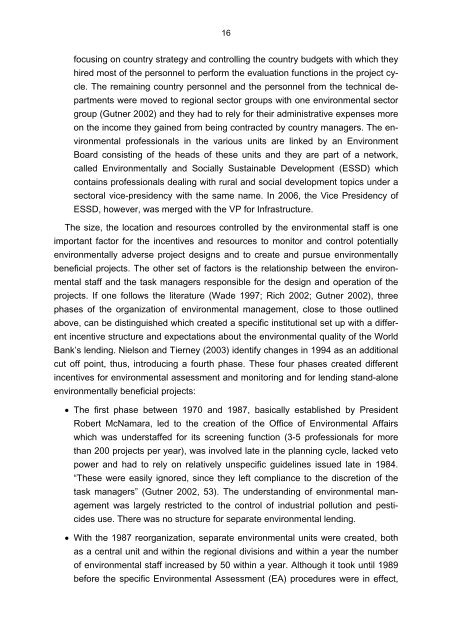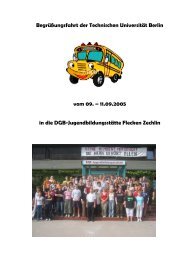Elegantes Telefax - JAV der TUB - TU Berlin
Elegantes Telefax - JAV der TUB - TU Berlin
Elegantes Telefax - JAV der TUB - TU Berlin
Create successful ePaper yourself
Turn your PDF publications into a flip-book with our unique Google optimized e-Paper software.
16<br />
focusing on country strategy and controlling the country budgets with which they<br />
hired most of the personnel to perform the evaluation functions in the project cycle.<br />
The remaining country personnel and the personnel from the technical departments<br />
were moved to regional sector groups with one environmental sector<br />
group (Gutner 2002) and they had to rely for their administrative expenses more<br />
on the income they gained from being contracted by country managers. The environmental<br />
professionals in the various units are linked by an Environment<br />
Board consisting of the heads of these units and they are part of a network,<br />
called Environmentally and Socially Sustainable Development (ESSD) which<br />
contains professionals dealing with rural and social development topics un<strong>der</strong> a<br />
sectoral vice-presidency with the same name. In 2006, the Vice Presidency of<br />
ESSD, however, was merged with the VP for Infrastructure.<br />
The size, the location and resources controlled by the environmental staff is one<br />
important factor for the incentives and resources to monitor and control potentially<br />
environmentally adverse project designs and to create and pursue environmentally<br />
beneficial projects. The other set of factors is the relationship between the environmental<br />
staff and the task managers responsible for the design and operation of the<br />
projects. If one follows the literature (Wade 1997; Rich 2002; Gutner 2002), three<br />
phases of the organization of environmental management, close to those outlined<br />
above, can be distinguished which created a specific institutional set up with a different<br />
incentive structure and expectations about the environmental quality of the World<br />
Bank’s lending. Nielson and Tierney (2003) identify changes in 1994 as an additional<br />
cut off point, thus, introducing a fourth phase. These four phases created different<br />
incentives for environmental assessment and monitoring and for lending stand-alone<br />
environmentally beneficial projects:<br />
• The first phase between 1970 and 1987, basically established by President<br />
Robert McNamara, led to the creation of the Office of Environmental Affairs<br />
which was un<strong>der</strong>staffed for its screening function (3-5 professionals for more<br />
than 200 projects per year), was involved late in the planning cycle, lacked veto<br />
power and had to rely on relatively unspecific guidelines issued late in 1984.<br />
“These were easily ignored, since they left compliance to the discretion of the<br />
task managers” (Gutner 2002, 53). The un<strong>der</strong>standing of environmental management<br />
was largely restricted to the control of industrial pollution and pesticides<br />
use. There was no structure for separate environmental lending.<br />
• With the 1987 reorganization, separate environmental units were created, both<br />
as a central unit and within the regional divisions and within a year the number<br />
of environmental staff increased by 50 within a year. Although it took until 1989<br />
before the specific Environmental Assessment (EA) procedures were in effect,





